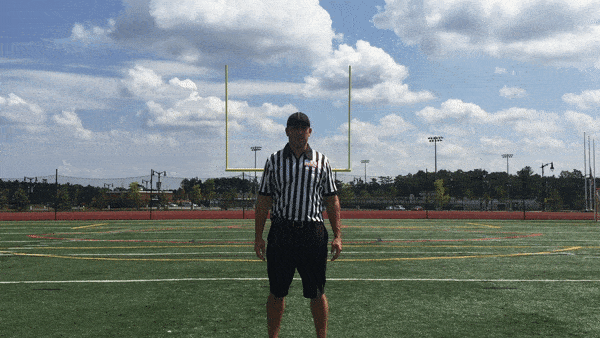A touchback in football can often be seen on kickoffs, offense, and defense. It’s a ruling in football that moves the ball to a specific position on the field. But what is a touchback and why is it important?
A touchback in football is when the ball is downed behind the goal line after a kick or an interception. The ball is then placed on the 25-yard line of the team that got the touchback.
In this article, we will explain what is a touchback in football and all the possible scenarios for a touchback.
What Is A Touchback In Football?
A touchback in football is when the kicking team kicks the ball out of the receiving team’s end zone. The ball is automatically spotted on the 25-yard line, where the offense will start their drive.
According to the NFL Rulebook, “A touchback in football is when the ball becomes dead on or behind the goal line a team is defending, provided that the impetus comes from an opponent and that it is not a touchdown or an incomplete pass.” The ball is automatically reset at the 25-yard line for the offense.
When the kicking team kicks the ball into the receiving team’s goal line, there’s a strong possibility the returner will take a knee. There is too much risk in running the ball out from the back of the end zone.
Most returners are taught that if the ball goes over the goal line, take a knee.
A touchback is signaled by the referee when a player on the receiving team catches the ball (from a punt or kickoff) and takes a knee or runs out of the end zone. Once the receiving player takes a knee or runs out of the end zone, the referee will stop the play, and the ball will automatically be placed at the 25-yard line.
Here is how the referee will signal a touchback:
The receiving team’s offense will then come to the field, and the kicking team’s defense will come onto the field.
Teams will often elect to take a touchback because it gives them a better field position to start their drive. Rarely will a returning player take the ball out from their end zone as it may result in poor field position.
Only if the return team has a player they feel can impact the football game by returning the football will allow the player to return.
Players may also elect not to catch the football and let it roll out of the end zone. This is also considered a touchback; as long as no kickoff return players touch the football before reaching the end zone.
Increase Your Football IQ
Why spend hours on Google and YouTube trying to learn football yourself? We’ve created a simple guide to help make you the smartest person in the room.
College Football Fair Catch Touchback
It’s also common in college football to fair catch the kickoff.
In college football, teams can call for a fair catch if the ball lands inside of the 25 yard line. If the receiving team calls for a fair catch inside of the 25 yard line, the ball is automatically placed at the 25 yard line for the offense to start their drive.
This rule change was put in place as kickoff can often be the most dangerous play in football. The fair catch makes the ball dead and no contact can be made on the returner.
If a fumble occurs, the ball is live and the touchback rule is no longer in play. The team who kicked the ball has a chance to recover the ball if the ball carrier fumbles.
Touchback On a Punt
Another common touchback is when the punting team punts the ball out of the end zone. It will be ruled a touchback as soon as the football crosses the opponent’s goal line after being kicked.
This is an exciting play in football, as players typically are acrobatic, trying to save the football from going into the end zone.
If the punting team touches the football and the ball travels into the end zone, this will also result in a touchback. When punting, the ball must stay in the field of play or out of bounds to avoid a touchback.
Touchback On Offense
The second type of touchback is on offense. This type of play is rare, but it can happen. The most common offensive touchback is when the player fumbles out of the opponent’s end zone.
A perfect example of this is when DK Metcalf caught the football but celebrated a bit too early, which resulted in a player on the defensive team punching the ball out of his hands.
After the ball rolled out of the end opponents’ end zone, the play automatically ruled a touchback.
Once the ball is fumbled out of the opponent’s end zone by the offensive team, the opposing team takes possession of the ball, starting at the 25 yard line.
It’s a weird rule that may not make sense to some, but touchbacks on offense can hurt a drive if they fumble out of the opponent’s end zone. If they fumble out of their own end zone, it will result in a safety which we wrote about here where the defense will get two points.
Touchbacks on offense are also called when offensive players try to dive for the pylon but lose control of the football and fumble it out of the end zone.
This happened to Derek Carr as he dove for the pylon and lost control of the football, ultimately fumbling it through the opponent’s end zone.
Touchback Rules In Football
American football rules state that on any touchback, the ball is automatically brought to the 25-yard line.
After a touchback on a kickoff return, the returning offense will come on the field, and the kicking team’s defense will come on the field.
If the offense fumbles the ball out of the opponent’s end zone on offense, the ball is turned over to the other team, and their offense comes on the field.
Touchbacks play an essential role in football as they help keep the football in play. If teams decide to kick the ball as far as they want, they may elect to have the other team take the ball at the 25-yard line.
If the other team has a dangerous returner, this may be a good idea to prevent him from making an explosive play.
Kicking the ball deep into the end zone or deep enough not to return is beneficial to prevent the returner from making a big play.
Increase Your Football IQ
Why spend hours on Google and YouTube trying to learn football yourself? We’ve created a simple guide to help make you the smartest person in the room.
Keep Learning
The National Football League features a touchback on almost every kickoff. This is because the kickers in the NFL have very strong legs and almost always kick the ball out of the opposing team’s end zone.
Kicking teams still need to run full speed down the field because they don’t know if the receiving team will take the ball out or if it’s called dead with a touchback.
Once the ball touches the end zone or goes out of the back end zone, the referee will blow the whistle.
If you liked learning football, we recommend you take our Beginners Guide To Football course. it will help to drastically improve your Football IQ!
Touchbacks can be seen in almost every NFL & college game. They’re rarely seen in high school games, as kickers don’t often have the leg strength to reach the end zone. Therefore the return team will always get possession of the ball and try to score.
Touchbacks can help with starting field position if they choose to take it. Often coaches will play it safe and have their returner take a knee to bring their offense onto the field and get the ball at the 25-yard line.





